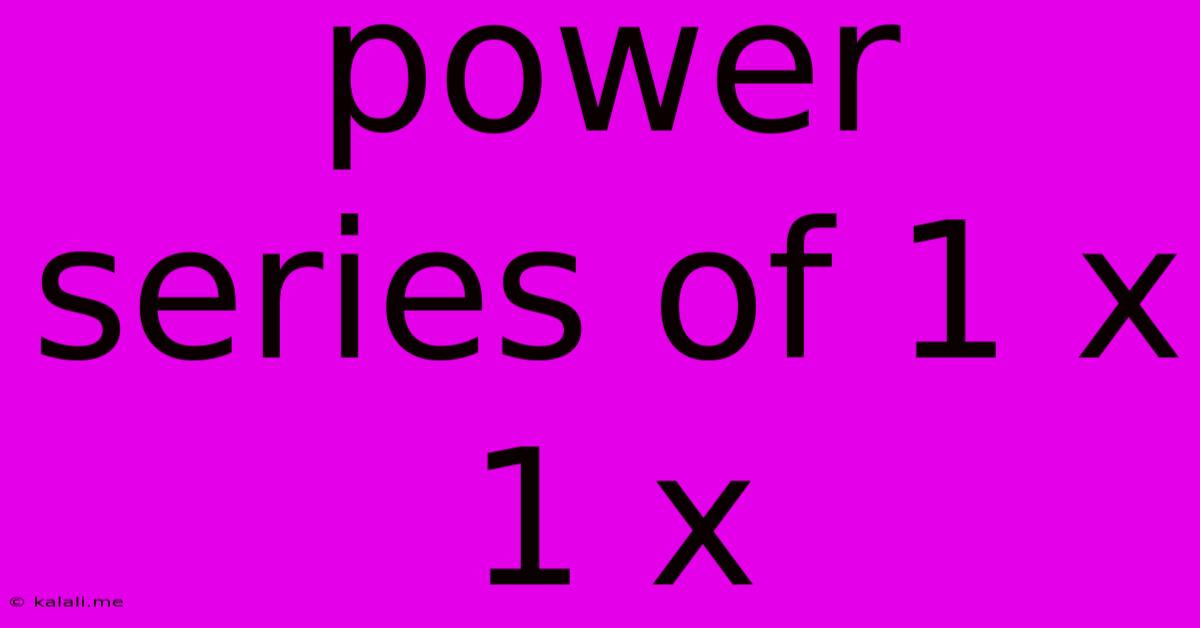Power Series Of 1 X 1 X
Kalali
May 24, 2025 · 3 min read

Table of Contents
Power Series Representation of 1/(1-x)
This article explores the power series representation of the function f(x) = 1/(1-x), a fundamental concept in calculus and crucial for understanding many other power series expansions. We'll delve into its derivation, radius of convergence, and applications. Understanding this power series is key to mastering techniques like Taylor and Maclaurin series expansions.
What is a Power Series?
A power series is an infinite series of the form:
∑<sub>n=0</sub><sup>∞</sup> a<sub>n</sub>(x-c)<sup>n</sup> = a<sub>0</sub> + a<sub>1</sub>(x-c) + a<sub>2</sub>(x-c)<sup>2</sup> + ...
where:
- a<sub>n</sub> are constants called coefficients.
- c is a constant called the center of the series.
- x is a variable.
Deriving the Power Series for 1/(1-x)
The power series for 1/(1-x) can be derived using the geometric series formula. Recall that the sum of an infinite geometric series is given by:
S = a / (1 - r)
where:
- a is the first term.
- r is the common ratio.
This formula is valid only when |r| < 1.
Let's consider the series:
1 + x + x<sup>2</sup> + x<sup>3</sup> + ...
This is a geometric series with a = 1 and r = x. Therefore, the sum of this series is:
S = 1 / (1 - x)
provided |x| < 1. This directly gives us the power series representation:
1/(1-x) = ∑<sub>n=0</sub><sup>∞</sup> x<sup>n</sup> = 1 + x + x<sup>2</sup> + x<sup>3</sup> + ...
Radius of Convergence
The radius of convergence for this power series is 1. This means the series converges for -1 < x < 1. At the endpoints x = -1 and x = 1, the series converges conditionally and diverges, respectively. The interval of convergence is (-1, 1). Beyond this interval, the series diverges.
Applications and Importance
The power series expansion of 1/(1-x) is incredibly useful in many areas of mathematics and its applications including:
- Deriving other power series: It serves as a building block for finding power series representations of other functions through techniques like substitution and differentiation/integration. For example, by substituting -x² for x, we can derive the power series for 1/(1+x²).
- Approximating functions: The series provides a way to approximate the value of 1/(1-x) for values of x within the interval of convergence. The more terms included in the summation, the more accurate the approximation becomes.
- Solving differential equations: Power series solutions are often employed to solve differential equations that lack elementary solutions.
- Calculus: Understanding this series is fundamental to grasping concepts like Taylor and Maclaurin series.
Conclusion
The power series representation of 1/(1-x) is a fundamental concept with broad applications across mathematics and related fields. Understanding its derivation, radius of convergence, and its significance as a building block for other series expansions is essential for anyone studying calculus or related subjects. Its simplicity belies its immense power and importance in advanced mathematical analysis.
Latest Posts
Latest Posts
-
Alts Platforms Other Than Linux And Windows Are Not Supported
May 24, 2025
-
What Does Raca Mean In The Bible
May 24, 2025
-
How Do You Say Cute In Spanish
May 24, 2025
-
How To Fix A Hole In A Door
May 24, 2025
-
How Often Should I Change My Furnace Filter
May 24, 2025
Related Post
Thank you for visiting our website which covers about Power Series Of 1 X 1 X . We hope the information provided has been useful to you. Feel free to contact us if you have any questions or need further assistance. See you next time and don't miss to bookmark.